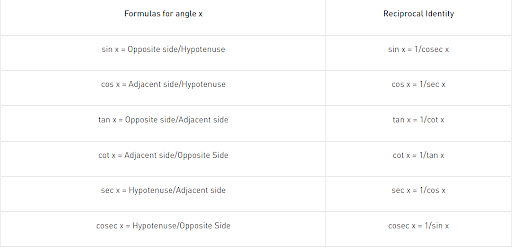Given 15 cot A = 8. Find sin A and sec A.
Solution and Explanation
Consider a right-angled triangle, right-angled at B.
\(\text{ cot A} = \frac{\text{Side}\ \text{ Adjacent}\ \text{ to}\ ∠A }{\text{Side}\ \text{ Opposite}\ \text{ to}\ ∠A }\)
\(\frac{AB}{BC}\)
It is given that,
cot A =\(\frac{8}{15}\)
\(\frac{AB}{BC}=\frac{8}{15}\)
Let AB be 8k. Therefore, BC will be 15k, where k is a positive integer.
Applying Pythagoras theorem in \(Δ\)ABC, we obtain.
\(\text{AC}^ 2 =\text{ AB}^ 2 +\text{ BC}^ 2\)
\(= (8k)^ 2 + (15k) ^2\)
\(= 64k ^2 + 225k ^2\)
\(= 289k^ 2\)
AC = 17k
\(\text{ sin A} = \frac{\text{Side}\ \text{ Opposite}\ \text{ to}\ ∠A }{\text{Hypotenuse}}\)
\(\frac{BC}{AC}= \frac{15}{17}\)
\(\text{ sec A} = \frac{\text{Hypotenuse}}{\text{Side}\ \text{ Adjacent}\ \text{ to}\ ∠A }\)
\(\frac{AC}{AB}=\frac{17}{8}\)
Top Questions on Trigonometric Ratios
If $\tan \theta = \tfrac{3}{4}$, then the value of $\cos \theta$ will be:
- UP Board X - 2025
- Mathematics
- Trigonometric Ratios
- Evaluate \( \dfrac{2 \tan 30^\circ}{1 + \tan^2 30^\circ} \)
- AP POLYCET - 2025
- Mathematics
- Trigonometric Ratios
- If \( 15 \cot A = 8 \), then \( \sin A = \, ? \)
- AP POLYCET - 2025
- Mathematics
- Trigonometric Ratios
- Evaluate \( (\sec A + \tan A)(1 - \sin A) = \ ? \)
- AP POLYCET - 2025
- Mathematics
- Trigonometric Ratios
- Which of the following is true?
- AP POLYCET - 2025
- Mathematics
- Trigonometric Ratios
Questions Asked in CBSE X exam
- Why is Matilda unhappy with her life?
- CBSE Class X - 2025
- The Necklace
आप अदिति / आदित्य हैं। आपकी दादीजी को खेलों में अत्यधिक रुचि है। ओलंपिक खेल-2024 में भारत के प्रदर्शन के बारे में जानकारी देते हुए लगभग 100 शब्दों में पत्र लिखिए।
- CBSE Class X - 2025
- पत्र लेखन
- How did the Civil Disobedience Movement become a mass movement? Explain with examples.
- CBSE Class X - 2025
- Nationalism in India
- Write one function each of the parts - (i) petals (ii) anther (iii) style and (iv) ovary of a bisexual flower.
- CBSE Class X - 2025
- How Do Organisms Reproduce
- Suggest any two measures to promote secularism as mentioned in the Indian Constitution.
- CBSE Class X - 2025
- Gender, Religion and Caste
Concepts Used:
Trigonometric Functions
The relationship between the sides and angles of a right-angle triangle is described by trigonometry functions, sometimes known as circular functions. These trigonometric functions derive the relationship between the angles and sides of a triangle. In trigonometry, there are three primary functions of sine (sin), cosine (cos), tangent (tan). The other three main functions can be derived from the primary functions as cotangent (cot), secant (sec), and cosecant (cosec).
Six Basic Trigonometric Functions:
- Sine Function: The ratio between the length of the opposite side of the triangle to the length of the hypotenuse of the triangle.
sin x = a/h
- Cosine Function: The ratio between the length of the adjacent side of the triangle to the length of the hypotenuse of the triangle.
cos x = b/h
- Tangent Function: The ratio between the length of the opposite side of the triangle to the adjacent side length.
tan x = a/b
Tan x can also be represented as sin x/cos x
- Secant Function: The reciprocal of the cosine function.
sec x = 1/cosx = h/b
- Cosecant Function: The reciprocal of the sine function.
cosec x = 1/sinx = h/a
- Cotangent Function: The reciprocal of the tangent function.
cot x = 1/tan x = b/a
Formulas of Trigonometric Functions:
